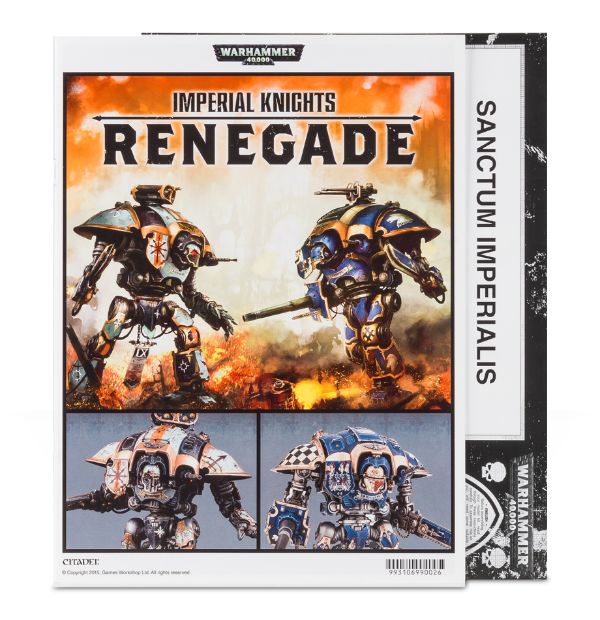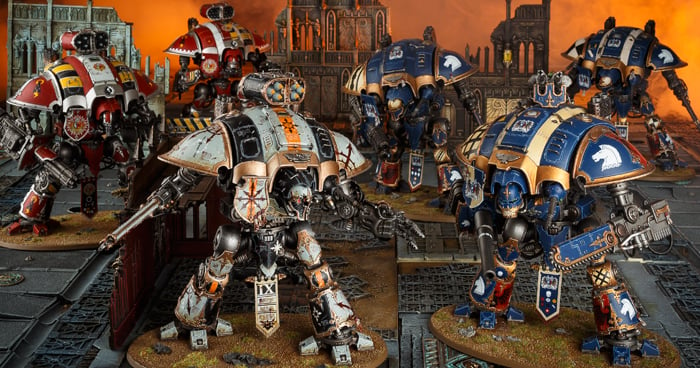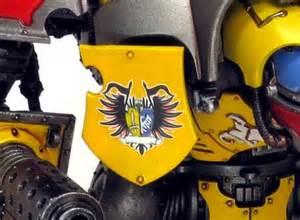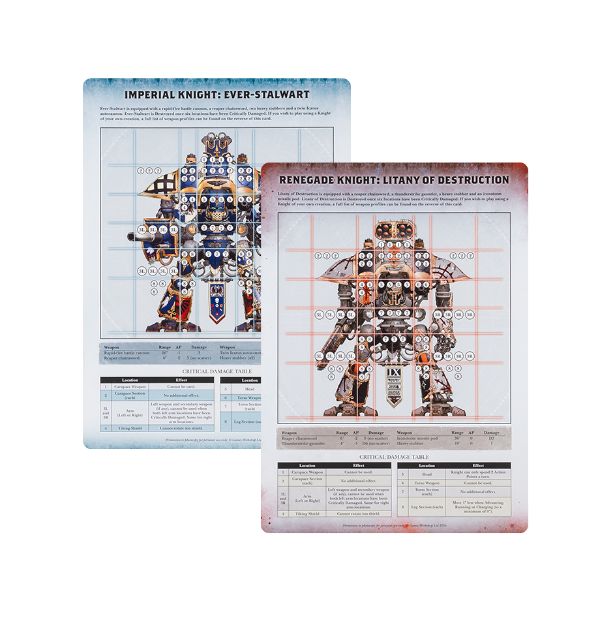40K: Detailed Renegade Rules Breakdown


Dan takes a deep dive into Imperial Knights: Renegade!
The box arrived yesterday, and I have read the rules in detail. This game is nothing like we were expecting..
To start off, this “game” has very little in common with 40k, other than the models and the names of the weapons. The mechanics are completely different; combat, weapons profiles, movement and turn order are all unique to this game. In fact, other than the Damage Location Grid for each Knight, there are only three pages of rules, including the missions! OK Dan, so do you like it since it’s so different? The answer is “you bet!” Before that though, a few basics regarding missions (there are three). The game is played on a 4ft x 4ft board. There are very specific instructions on the initial placement of both Knights and the two terrain pieces…which you will have to move around to avoid; more on that later. Finally there are objectives for each mission.
Let’s go through the two main parts of a turn…the Planning and the Execute phases.
Planning: This is, in essence, the turn order system for the game. The most unique aspect of Planning is that turn order is not “I go-you go.” Each Knight gets 3 actions points (APs), and there are 7 actions to choose from. Each action uses a specific number of action points, and takes place in a specific order. Each player secretly writes down their action choices, and then actions are executed in a specific order. For example, if you choose to Snap Shot for 1AP, you would go before the other Knight that selected Run (1AP) as its first action. Also, you cannot choose to use any action more than once in a game turn. So I could choose to Snap Attack (1AP) and Standard Attack (2AP), or Advance (1AP), Rotate Ion Shields (1AP) and Run (1AP). I couldn’t Snap Attack or Run twice in a single turn. If both players choose the same action, they roll off to see who goes first. That’s pretty much it for the Planning Phase. There is, of course, a handy table to use for selecting your actions.
Execute: We will break this down by action types, starting with Move actions.
– Move Actions. There are three type of move actions; Advance, Run and Charge. Each allows your Knight to move a distance unique to that action. The Charge move allows you to attack with Melee weapons immediately after you move. Given the profile of the Run and Charge actions, you could theoretically move up to 18″ and finish off your move by smacking your opponent with a nasty melee weapon. Here is an interesting tidbit for those who are all worked up about the “no moving through ruins” FAQ response. The Renegade game rules very specifically state that a Knight…”cannot move through another Knight OR a ruined building – it will have to manoeuvre around them.” Does this sound familiar? Maybe GW really doesn’t want you moving through ruined walls. If a Knight can’t do it, I find it hard to believe anything else in the game can. Just sayin. Another mechanic requires both Knights to face each other after they have completed moving…”honor demands it.” Ion Shields always face to the front, and you will always be shooting your opponent in the face (or some other anatomical feature).
– Attacking Actions. We should discuss weapons profiles for this game before anything else. Yes, the standard Knight weapons kit is here. but the profile details (range, AP and damage) are very different from those in a Knight codex. Most of the ranges are much shorter; Avenger and Battle Cannons are both less than 30″. The AP value is a die modifier to determine whether damage takes place, not what the result will be on a Vehicle Damage Chart. Most damage is variable, either D3 or D6, and can scatter (except melee weapons).
To determine damage, each Knight has a Damage Location Grid. It is similar to the way damage was allocated in Battle Tech. I would strongly recommend laminating these for ease of use; you are also given permission to copy them if you so desire. Back to the Grid. Each location on the Grid has a designated number of damage points (from 2-4). Once all the points for a specific Grid Location are gone, it counts as critical damage. If six of your Grid Locations suffer critical damage, you lose. Also, as Grids go critical, it affects your combat effectiveness in various ways. Weapons are lost if the Grids associated with them are critical. Can you picture that mini-shield next to the head of a Knight? This is a Tilting Shield, and if it is lost, you lose the “Rotate Ion Shield” action, which decreases your chances of avoiding damage. That thing isn’t just Knight bling in Renegade!
Another unique mechanic in Renegade is that your shot will not always impact the Grid location you aimed at. You have three choices of Attack modes; Aimed, Standard and Snap. Each attack mode has a different chance to hit, with Snap shots always deviating. Depending on the die roll for each die (you roll 1 red and 1 blue), your shot make be on target or deviate to the left, right, above or below your aim point. The red die can cause horizontal deflection, and the blue die creates vertical deflection. Importantly, if you are attacking with a melee weapon, you never scatter; pick a spot and smack your opponent around.
– Armour Saves and Damage. If your attack hits a location, the opponent roles a die and takes a negative modifier if the weapon has an AP value. Positive modifiers include cover and the Rotate Ion Shield action. Damage is inflicted, the weapons damage value is applied to the spaces in the affected Grid location. As stated earlier, if all of the damage in a specific grid is used up, the location goes critical; six critical locations means your Knight is out of action. Criticals before six can reduce combat effectiveness.
That’s the game. No really. That’s it. Like the rulebook states, the game is “…simple, quick and fun…”
Commentary: First, this seems like a great beer and pretzels game. It should not take more than 25-30 minutes to play, including set-up. As I said before, it will be nothing like two Knights facing off in a game of 40K. The mechanics are just so unique. That doesn’t mean it won’t be a challenge or fun. Just very different.
- You won’t need to have your Knight kitted out according to the Damage Grid diagram. It is generic enough to allow you to bring your Knight as is. The Grid diagram merely states “carapace weapon” or “left/right arm.” What your model actually has those locations equipped with will not affect the damage resolution. Once all the Grid locations for a weapon have gone Critical, the weapon cannot be used. It might be fun to pick your weapon load out secretly before a game, then reveal once the game is started. There is no limitation on weapon types, so you could go with two Thermal Cannons or Two Avengers, or a Reaper Chainsword and a Thuderstrike Gauntlet. Have at it!
- There is no difference between the Imperial and Renegade Knight in terms of game play. They appear different on the two Damage Diagrams, but since you can equip models as you wish, what your actual models look like doesn’t matter.
- This game has a nice potential for running a bracket style tournament. If you had 16 players bring Knights, you could do an NCAA-style elimination type event. The most games that would be played would be 4, including the finals. I’m sure folks could come up with other activities built around the game for those who lose their games in early rounds.
- This game is not designed for the Gladiator/Last Man Standing style game. It is designed to be a 1-on-1 confrontation.
- Renegade is the epitome of balance. Each player gets to choose from the same armory and each Knight has exactly the same Damage Grid. I think the real tactical part of this is figuring out combinations of Actions and which enemy systems to target. Do I go for the Head, which will reduce my opponents Action points? If he only has melee weapons, do I try to take out his legs and reduce his mobility? Do I go for weapon systems, which being on the exterior of the Damage Grid, create a higher chance of misses since shots can scatter off the Grid and do no damage?
- Melee weapons appear to have a distinct advantage, if only because they do not scatter. The trick will be to properly choose Actions that will get you into Charge range before your legs or weapons get blown off.
So there you have it. For those calling this another GW “boardgame,” it is anything but that. It is a great way to use your Knights to have a quick, fun throwdown with your mates and maybe have a good laugh in the process. Nothing serious about this. Line the Big Boys up and have at each other. Whether it’s “For The Emperor” or “Death To The Corpse God,” Renegade should provide some great entertainment value without the seriousness that sometimes overwhelms games of 40K.
Simple, Quick and Fun – It’s Robots duels to the death!







